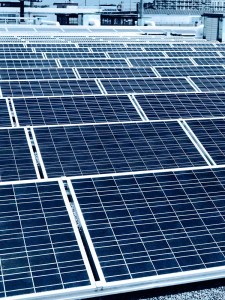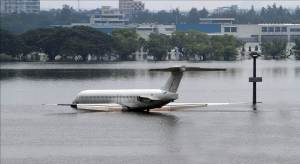More Companies are investing in Solar Projects
[tweetmeme source=”@nancyparmer” only_single=false]
 We are seeing more and more companies making investments is solar lately. One of the reasons is the price of solar panels have decreased over the last few years. Even through federal tax credits have been reduced or eliminated, there are several states that offer tax credits that makes it an great investment with a higher payback and better return on investment. Wal-Mart recently made an announcement to drive either production or procurement of renewable energy annually to reflect a 600% increase in 2010 levels. Another major commitment the company made was to reduce kWh per square foot or energy intensity required to power Wal-Mart’s buildings by 20% compared to 2010 levels. These two commitments will avoid 9 million metric tons of greenhouse gas emissions. Wal-Mart projects to have a decrease in GHG even with major growth in stores and sales if projections are accurate. Wal-Mart hopes to install solar on at least 1,000 facility rooftops by 2020. Currently they have 200 solar projects in the US.
We are seeing more and more companies making investments is solar lately. One of the reasons is the price of solar panels have decreased over the last few years. Even through federal tax credits have been reduced or eliminated, there are several states that offer tax credits that makes it an great investment with a higher payback and better return on investment. Wal-Mart recently made an announcement to drive either production or procurement of renewable energy annually to reflect a 600% increase in 2010 levels. Another major commitment the company made was to reduce kWh per square foot or energy intensity required to power Wal-Mart’s buildings by 20% compared to 2010 levels. These two commitments will avoid 9 million metric tons of greenhouse gas emissions. Wal-Mart projects to have a decrease in GHG even with major growth in stores and sales if projections are accurate. Wal-Mart hopes to install solar on at least 1,000 facility rooftops by 2020. Currently they have 200 solar projects in the US.
Read more…
Green Packaging, Reusable Pallets, Totes and Boxes
[tweetmeme source=”@nancyparmer” only_single=false]
How many of you are aware of a bill that was passed back in 2000 by Two Congress members from California that provides incentives for businesses to reuse pallets and plastic containers? Representatives Dana Rohrabacher, a Republican, and Bob Matsui, a Democrat, introduced the Landfill Reduction Act of 2000 (HR 4916), which would provide tax incentives to businesses that stop using disposable wooden pallets and cardboard boxes.
Under the terms of the bill, farmers, retailers, manufacturers and poolers of reusable plastic or wooden pallets and plastic containers could write off the cost of capital investments to convert to these environmentally friendly products. This is a great opportunity for companies to take a real look at the packaging. Many companies do not realize the impact packaging has on the environment not to mention the amount of money that is used to get rid of corrugated boxes and wooden pallets.
Packaging is a way to protect the contents of your shipment. It can help control costs by minimizing package dimensions, weight and required transport space. Its design, format and materials content, for better or worse, constitute brand statements. And packaging speaks volumes about a company’s desire to reduce your overall impact on the environment.
Consumers, meanwhile, are looking for greener products. A recent Accenture study of 7,500 consumers in 17 countries found that 64% say they are willing to pay a higher price for products and services that produce lower greenhouse-gas emissions. E-tailers are therefore thinking strategically about making their packaging both cost-effective and environmentally friendly.
That’s heavy lifting for a humble piece of cardboard or plastic. But sustainable companies pride themselves on embracing green practices are discovering what’s on the outside of a product can be as important as what’s on the inside.
The Impact Climate Change has on Logistics
[tweetmeme source=”@nancyparmer” only_single=false]

The risk of climate change related business interruption is substantial and often treated as if it were zero. If a company prices this risk, there will be funds available for investing in strategies to prepare for and respond to business interruption caused by increasingly intense weather events as the climate changes.
All businesses plan for business continuity, but the world we know is changing. The frequency and severity of storms is increasing, and new types of catastrophic weather events are more common and more devastating (floods, tornadoes, drought, fire, fierce winds and destructive hail or other precipitation).
These catastrophic events can interrupt business, destroy infrastructure, manufacturing and other facilities, fleets and equipment as well power. It can take days, weeks, months or years to recover public infrastructure and private assets. In the meantime losing millions or even billions of dollars of sales, much less the direct costs of recovery.
Because of the politicization of the topic of climate change, many businesses have not implemented a strategy to address the profound changes that they are witnessing. Uncertainty about when and where weather events will occur and their severity and impact make this a very complicated challenge.
Climate science indicates that the changes are real and likely to result in increasingly severe weather and changes in precipitation, sea level, and extended heat waves.
Weather systems are chaotic and may be getting even harder to predict with precision and sufficient advanced warning for nimble response.
Therefore, companies need to consider investing in proactive strategies to protect themselves from the business consequences of natural disasters.
What can companies do? This was the subject of my presentation at Sustainable Silicon Valley West Summit 2012.
University of Iowa – Leading the Way in Energy Management
[tweetmeme source=”@nancyparmer” only_single=false]
I recently had the chance to tour the University of Iowa’s Energy Control Center and it was amazing! The control center is the epicenter for capturing energy consumption data for the entire campus. This is not a simple task; University of Iowa’s campus is 17 million square feet. They are able to capture and track energy consumption real-time. With the tools and processes in place, they can obtain huge energy, carbon and most important dollar savings.
The control center has four large television monitoring systems. These monitors can capture over 100,000 data trend points, including boiler and water chiller operating capacities. It also has a satellite image of the United States showing looped weather radar. This enables the engineers on campus to analyze data and incorporate weather forecasts to manage their chillers, boilers and turbines usage to power the campus based on 24 hour weather condition changes. Future improvements may include expanding that 24 hour window for weather changes as this will allow the campus to have even larger savings in energy and have more flexibility to adapt to weather conditions and possible natural disasters like the flood in 2011.
Literally, every facility on campus can view both energy consumption and utility costs via the web anytime day or night. This tool also allows each facility to track and provide feedback on conservation efforts. Visibility is important for facilities to monitor and ensure energy efficiency gains are achieved at the building level. So far this has proved to be successful. They have an Energy Conservation and Management Plan in place with a target goal for 10% energy reduction by 2013 using 2003 as the baseline. They are on target to meet this goal.
Another impressive area the University has focused on is renewable energy. They are a leader in renewable energy strategies. There environmental portfolio include Biomass Fuels from oat hulls through partnership with Quaker Oats. Other examples include Landfill Gas, Oakdale Renewable Energy Plant, and Alternative energy sources. UI has a goal of 40% renewable energy consumption on campus by 2020. Currently, one fourth of campus really believes that this University will become one of the first campuses to become a Net Negative Energy Consumer. This will be a huge accomplishment when most campuses have a Net Zero goal. Congratulations, University of Iowa for all of your efforts in helping the environment and also your triple bottom line.
Implementing California’s Cap-and-Trade: A Focus on Revenue Allocation
[tweetmeme source=”@nancyparmer” only_single=false]
I wrote a blog last year describing how the cap-and-trade program will work. This blog is focused on the projected revenue and where the funds will be allocated. The recent Navigating the American Carbon World conference held in San Francisco, highlighted the on-going discussion about how best to allocate the revenues.
The California cap-and-trade program is expected to generate $1 billion dollars in its first year of implementation and could generate as much as $12 billion annually as the program expands. It is estimated there will be $60 billion in revenue from auctions by 2020.
Governor Brown has two important bills in the 2012 Legislative session that focuses on cap-and-trade revenues. His office efforts on energy efficiency include: aggressive renewable energy expansion, enhancements to the grid, clean air technology, electric vehicles and infrastructure. He also wants the planned high speed rail project to move forward, where trains running at 220 mph would carry passengers between the San Francisco Bay area, the Central Valley, and Southern California.
Colleges and Universities Innovative Green Financing Model – Green Revolving Funds
[tweetmeme source=”@nancyparmer” only_single=false]
 Green Revolving Funds (GRF’s) are becoming the norm for many college and universities. The main reason institutions are creating GRF’s is because institutions understand the importance of implementing sustainability projects and they want to ensure a stream of financing is available to invest in projects. I think it is important to define Green Revolving Funds (GRF’s). GRF’s are funds that invest in energy-efficient projects to reduce energy usage and reinvest monies saved for future projects. These projects typically repay the loan through an internal account transfer from the savings made in the institutions utility budget.
Green Revolving Funds (GRF’s) are becoming the norm for many college and universities. The main reason institutions are creating GRF’s is because institutions understand the importance of implementing sustainability projects and they want to ensure a stream of financing is available to invest in projects. I think it is important to define Green Revolving Funds (GRF’s). GRF’s are funds that invest in energy-efficient projects to reduce energy usage and reinvest monies saved for future projects. These projects typically repay the loan through an internal account transfer from the savings made in the institutions utility budget.
One key finding is colleges and universities that participate in sustainability projects have reduced both their operating expenses and greenhouse gas emissions. GRF’s are good mechanisms to regenerate funds for future projects. Studies have shown projects on average have a 32 percent return on investment annually for energy-efficient reduction projects. This is very appealing especially in today’s bad economy, with rising energy prices and issues around resource scarcity, it becomes more of a business imperative to invest in energy reduction projects on campus.
Highlights of the 2011 Navigating the American Carbon World Conference
[tweetmeme source=”@nancyparmer” only_single=false]
I was able to attend this years NACW conference in Los Angeles and it was as exciting and informative as the past conferences. I always look forward to attending this event because it has a balanced mix of attendees to include governmental agencies, non governmental agencies, and companies that incorporate sustainability in almost every conversation they have because it is their way of life.
I want to share some of the conference highlights for those of you that were not able to attend this year. This year’s event was kicked off by Arnold Schwarzenegger, Former Governor, State of California. Arnold addressed the importance of creating balance between the environment and the economy. The signing of AB32 was an historic event for the Schwarzenegger administration. He emphasized how other states need to show a plan to reduce greenhouse gases. He gave an example of how Chinese provinces are way ahead of national governments in the solar energy sector. He spent sometime discussing a hot topic “Green Jobs” Arnold stated that the green segment produces ten times more jobs than any other sector, and one third of the green jobs are in the state of California due to the focus on climate change policies and the implementation of AB32.
Corporate Sustainability: Building Partnerships to Achieve Goals
[tweetmeme source=”@nancyparmer” only_single=false]
On March 17th, 2011 I was honored to co-present with my counterpart John Malian, Global Supply Chain Manager – Design for Sustainability at Cisco Systems at Hanson Bridgett’s monthly sustainable business leadership forum in San Francisco, CA. Throughout the highly interactive forum we had dialogue centered on how we have partnered to reduce greenhouse gases within the supply chain. We also discussed the importance of sharing best practices. Both UPS and Cisco have very similar approaches in addressing environmental sustainability. We create efficiencies in our network and develop innovative green products and service offerings. Both companies strive to provide environmental conscious solutions to our customers. We both collaborate with customers, industry groups, government, non-governmental organizations, and employees to address environmental issues.
Both UPS and Cisco Systems have sustainability committees whose strategy is to develop and implement sustainability programs for both our internal and external customers. We both believe it is important to develop a long term strategy that impacts sustainability into their operations. Data and numbers will make it possible to make better decisions. You cannot manage what you cannot measure. You cannot mitigate your impact without measurement. Both companies have been reporting to the carbon disclosure project since 2003 when the program was first rolled out. We both understand the importance of being transparent and accurate reporting.
Cap and Trade – A Closer Look at California’s Strategy to Combat Climate Change
[tweetmeme source=”@nancyparmer” only_single=false]
Why is California doing this? Under the Global Warming Solutions Act of 2006 (also known as AB 32), the law requires the state to reduce GHG emissions to 1990 levels by 2020 which equates to 427 million metric tons of carbon dioxide equivalent. In December 2010, California’s Air Resources Board (ARB) voted to adopt regulations to establish the largest greenhouse cap-and-trade system in the U.S. A combination of ‘early action’ programs and a cap-and-trade system will be used to meet California’s ambitious GHG reduction target goal.
When is this being implemented? The first part of the process will starting by February 2012, the first carbon permits are scheduled to be distributed to major Industrial emitters and Utilities, with GHG emissions of more than 25,000 metric tons per year. Under the cap and trade program free allowances will be given out from 2012-2014. Starting in 2015, the program will include distributors of transport fuels, natural gas and propane. The GHG cap to be determined in 2012, will be reduced by 2% annually during 2012-2014 and then by 3% annually during 2015 – 2020.
How will this work? Let’s say Company “A” is located in San Jose, California and is 15% under it’s pollution allowances, it can sell the unused portion to Company “B” in Ventura, California that has exceeded its quota allowed. Company “A” can keep the money obtained from the sell of the unused allowances to Company “B”. In addition to the allowances, regulated industries can also offset 8% of their GHG emissions by investing in carbon offset programs outside California, including Brazil and Mexico. California is developing the first compliance carbon market to include improved forest management as a source of carbon offsets.

 Hi, and welcome to my blog. My name is Nancy Parmer, Sustainability, Customer Solutions at UPS.
Hi, and welcome to my blog. My name is Nancy Parmer, Sustainability, Customer Solutions at UPS.
